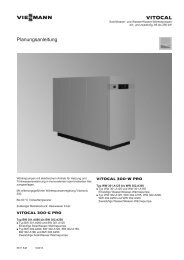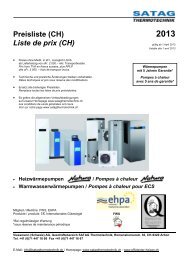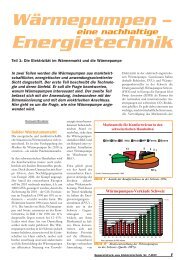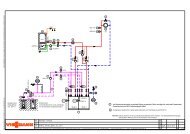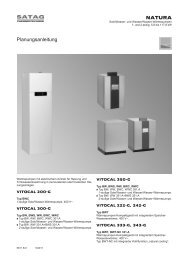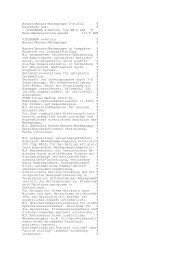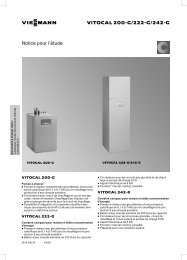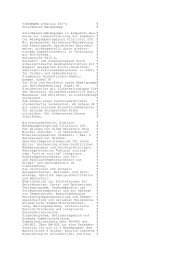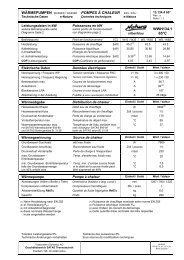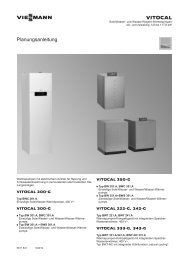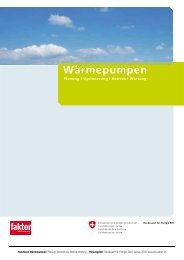TITLE, PLEASE USE 14-pt ARIAL FONT, BOLD, CENTERED - SATAG
TITLE, PLEASE USE 14-pt ARIAL FONT, BOLD, CENTERED - SATAG
TITLE, PLEASE USE 14-pt ARIAL FONT, BOLD, CENTERED - SATAG
You also want an ePaper? Increase the reach of your titles
YUMPU automatically turns print PDFs into web optimized ePapers that Google loves.
P3.275 - 1 -<br />
EFFECTS OF ELECTRONIC EXPANSION VALVES ON HEAT PUMP<br />
PERFORMANCE<br />
Hansueli Bruderer, Dr. sc. tech. ETH, Hans Hohl, Dipl. Ing. HTL, Viessmann (Switzerland)<br />
Inc., Division <strong>SATAG</strong> Thermotechnics, CH-9320 Arbon, Switzerland<br />
Abstract: The use of electronic expansion valves in heat pumps allows a preciser run of the<br />
superheat of the refrigerant. Enhanced new products for this purpose are now available. With<br />
them, the designer can define the cycle continuously (stepless) compared with today's<br />
compromise using fix adjusted thermostatic expansion valves. Over the whole range of<br />
application the delivered capacity is piloted. Of special interest are situations as for example<br />
air/water heat pump with air inlet temperatures above + 15 °C. The control of the electronic<br />
component is to integrate in the heat pump control procedure in order to guarantee an<br />
o<strong>pt</strong>imized run of the whole heat pump system with all its changing data. The paper shall<br />
present the latest developments and first test results, how and how far COP's and especially<br />
SPF (seasonal performance factor) can be improved by the use of electronic expansion<br />
valve. The research shall also reduce the application cost of the electronic expansion valves<br />
in order to allow the wide application also in small heat pumps.<br />
Key Words: heat pumps, electronic expansion valve, efficiency<br />
1 INTRODUCTION<br />
In the late nineties the small heat pumps till 100 kW thermal output made a significant<br />
increase of overall performance by applying scroll compressors and new refrigerants as for<br />
example R407C, after 2000 followed by EVI (enhanced vapor injection) refrigerant-cycles to<br />
provide output temperatures of + 65 °C. The today's potential to increase the performance of<br />
small heat pumps is to find more and more in the fine and dynamic tuning of the refrigerant<br />
cycle. There are different elements to consider for this dynamic run of the heat pump, for<br />
example variable compressor output, variable speed of ventilator, variable speed of<br />
circulation pumps. The electronic expansion valve is one of them. It's main influence is<br />
focused on the efficiency of the refrigerant cycle. For the individual components as well as for<br />
the interaction between them electronic control and ada<strong>pt</strong>ed software is necessary. In other<br />
words: the new generation of small heat pumps is characterized by dynamic operation and a<br />
dynamic refrigerant cycle. These heat pumps will be able to modulate the capacity similar as<br />
the capacity modulating wall hung boilers. And they shall be even more efficient over the<br />
whole year, having a higher seasonal performance factor.<br />
2 GENERAL EFFECTS OF ELECTRONIC EXPANSION VALVES (EEV)<br />
With the expansion valve, the refrigerant flow through the evaporator and its complete<br />
evaporation shall be controlled. The heat pump refrigerant cycle achieves its maximum<br />
efficiency, when a minimum and stable superheat before the compressor is granted [1]. Ideal<br />
would be dry evaporation with superheat 0 K, but in order to have a stable run a superheat of<br />
around 5-8 K is often applied. In the following explanations, the electronic expansion valve<br />
(EEV) is compared with the thermostatic expansion valve (TEV).<br />
9 th International IEA Heat Pump Conference, 20 – 22 May 2008, Zürich, Switzerland
P3.275 - 2 -<br />
2.1 Ada<strong>pt</strong>ation to changes: response time<br />
The ada<strong>pt</strong>ation after changes, for example of the heat load or heat demand, is visible by the<br />
oscillation around the targeted superheat. The EEV reacts with a shorter time period and<br />
smaller amplitude of the oscillation than the TEV. This is shown for the restart phase of a<br />
refrigerant cycle with R407C after a long stop in the experiments and diagram of<br />
Aprea/Mastrullo [2], see Figure 1. The same difference appears after other changes of the<br />
evaporator heat load.<br />
Fig. 1: Dynamic response of superheat (ΔTsur) after start [2]<br />
9 th International IEA Heat Pump Conference, 20 – 22 May 2008, Zürich, Switzerland
P3.275 - 3 -<br />
2.2 Stable superheat in all operation conditions of heat pump<br />
2.2.1 Stable superheat in the whole range of evaporator heat load<br />
The TEV is adjusted to the superheat (sh) at a certain operation point, for example to an<br />
outside temperature (Te) of minus 5 or 7 °C for an air/water heat pump. Due to it's control<br />
characteristic, the TEV only in small range able to keep the superheat stable, see result of<br />
measurements in a heat pump circuit changed from TEV to EEV in Fig. 2.<br />
Fig. 2: Test results show the difference between TEV and EEV<br />
The EEV however o<strong>pt</strong>imizes continuously the refrigerant flow rate and reaches a stable<br />
superheat under different heat load conditions of the evaporator. Fig. 3 shows the typical<br />
characteristic of an air/water heat pump in middle Europe with TEV and EEV. The further<br />
away from the standard operation point, the bigger the difference between the two valve<br />
versions. Thus, heat pumps with wide range of heat load conditions of the evaporator can<br />
take much profit using an EEV.<br />
9 th International IEA Heat Pump Conference, 20 – 22 May 2008, Zürich, Switzerland
P3.275 - 4 -<br />
Fig. 3: Superheat as a function of outside temperature for an air/water heat pump<br />
2.2.2 Stable superheat for variable output capacity modulation<br />
In another operation mode the stabilisation of the superheat is of special interest: when we<br />
operate with part load, especially when we modulate continuously the output capacity from<br />
around 20 to 100 % in a ratio of 1:5. Using a TEV, the reaction on the superheat is<br />
proportional to the output capacity Q o. At the smallest part load the superheat must be<br />
adjusted and increase proportionally when full load, for example from 5.5 K to 11 K. That<br />
means, the superheat at full load mode is not o<strong>pt</strong>imal and we are far away from the<br />
maximum efficiency at this operation point. For operation with part load for variable output<br />
capacity, the EEV is able to ada<strong>pt</strong> the refrigerant flow in order to keep the superheat stable<br />
on the calculated value, for example 5 K. In Fig. 4 the difference of the superheat between<br />
TEV and EEV is evident. The influence on the COP (coefficient of performance) in periods<br />
with high demand (full load or near to full load) is especially significant. The stabilisation of<br />
the superheat in every operation below 100 % load, in order to reach the particular maximum<br />
efficiency, is of high importance because of the specific higher electricity consum<strong>pt</strong>ion of the<br />
compressors in part load operation.<br />
9 th International IEA Heat Pump Conference, 20 – 22 May 2008, Zürich, Switzerland
P3.275 - 5 -<br />
Fig. 4: Superheat (sh) as a function of variable heat production realized by part load<br />
operation (modulation of output capacity Q o)<br />
3 APPLICATION FOR AIR/WATER HEAT PUMPS<br />
3.1 Different demands result in different requirements<br />
Heat pumps can provide different services: heat in the winter season, heat in the transient<br />
seasons, heat for domestic hot water production, heat for swimming pools, space cooling.<br />
Here the case study is an air/water heat pump with the purposes space heating and<br />
production of domestic hot water.<br />
3.1.1 Special requirements of space heating<br />
The air/water heat pump works more powerful and efficient the warmer the used outside air<br />
is. However: the warmer the outside air the lower the heat demand for the space heating is,<br />
see Figure 5.<br />
Fig. 5: Requirements of space heating for an air/water heat pump<br />
9 th International IEA Heat Pump Conference, 20 – 22 May 2008, Zürich, Switzerland
P3.275 - 6 -<br />
This contradiction and the high volatility of the outside air are reasons, why the design of air/<br />
water heat pumps requires far more effort and know how than water/water heat pumps.<br />
Both, the standard and the capacity modulating version of the air/water heat pump take<br />
advantage of the EEV. The standard type because of the wide range of the outside<br />
temperature (see 2.2.1), the capacity modulating type because of proportionality of<br />
superheat and Q o of TEV (see 2.2.2).<br />
3.1.2 Requirement for domestic hot water (DHW) production<br />
Domestic hot water (DHW) should be produced as quick as possible and the temperature in<br />
the DWH tank should be achieved as near as possible to the maximum temperature of the<br />
heat pump. Limiting is the heat exchanger capacity between heat pump and hot water. For a<br />
standard air/water heat pump the calculation of the heat exchanger must consider the<br />
capacity in warm seasons to have high pressure stops under control. During warm season,<br />
the difference of the superheat for DHW production is shown in Fig. 6. EEV is of advantage<br />
as the distance to the standard operation point creates for TEV an important ∆T to ideal<br />
superheat of 2 to 5 K.<br />
Fig. 6: unfavorable deviation of TEV for DHW in warm seasons (T e > 10°C)<br />
For the requirement to produce DHW as quick as possible, standard and capacity modulation<br />
version heat pump apply the full capacity or the calculated part load according to the heat<br />
exchanger. The second requirement to produce the maximum possible temperature in the<br />
DHW tank is given for the standard version by the Delta T of the mentioned heat exchanger.<br />
In the case of the capacity modulation type, at the maximum temperature can be approached<br />
with reduced ∆T by reducing step by step the capacity to the minimum part load. Therefore<br />
two advantages of the EEV help in this stage to o<strong>pt</strong>imize the efficiency of the heat pump: the<br />
better response time to changes, see 2.1, and the stable superheat during the modulation,<br />
see 2.2.2.<br />
9 th International IEA Heat Pump Conference, 20 – 22 May 2008, Zürich, Switzerland
P3.275 - 7 -<br />
3.2 Effect on COP and SPF for air/water heat pumps<br />
The effects of EEV on COP and SPF for air/water heat pumps are various. They are based<br />
on the three items of cha<strong>pt</strong>er 2: response time on changes, wide range of operation points<br />
and rate of capacity modulation.<br />
3.2.1 Static comparison of COP<br />
For the COP the comparison of single operation points at 100 % load is shown in Table 1.<br />
This static comparison shows differences from 2.2 to 17.5 %. The smallest difference occurs<br />
in the standard operation point (-7 / 45) , where the TEV is adjusted to the minimum<br />
superheat. The standard type values have been measured according to the previous<br />
standard EN 255. As the new standard EN <strong>14</strong>511 allows strictly only a ∆T of 5 K for the heat<br />
delivery, the calculated difference in COP is as reported or higher.<br />
COP for respective<br />
operation point (°C),<br />
according to<br />
respective EN<br />
Standard type with<br />
TEV, ca. 9 kW, EN<br />
255, [3]<br />
Capacity modulating<br />
type with EEV, ca.<br />
2-9 kW, EN <strong>14</strong>511,<br />
full load<br />
Difference in COP<br />
(%)<br />
2 / 35 3.3 3.8 <strong>14</strong>,8<br />
-7 / 35 2.7 2.8 3.7<br />
7 / 35 4.0 4.7 17.5<br />
-7 / 45 2.25 2.3 2.2<br />
2/ 45 2.7 3.0 11.1<br />
Table 1: Comparison of COP between TEV and EEV equipped air/water heat pumps<br />
3.2.2 Comparison of SPF<br />
In the comparison of SPF the dynamics of the use during a year are considered. The SPF<br />
can be calculated or simulated with standardised use under standardised conditions. In the<br />
following the German calculation method for application according to VDI Guideline 4650 [4]<br />
is done between the same air/water heat pumps as in 3.2.1. The use of EEV helps to reach a<br />
significant better SPF for the calculated place Frankfort (Germany), see Table 2.<br />
SPF according [4]<br />
for respective type<br />
with TEV or EEV,<br />
max. flow temp. +35<br />
°C<br />
Standard type with<br />
TEV, ca. 9 kW, EN<br />
255, [3]<br />
Capacity modulating<br />
type with EEV, ca.<br />
2-9 kW, EN <strong>14</strong>511,<br />
full load<br />
Deviation of SPF (%)<br />
SPF 3.77 4.33 + <strong>14</strong>.8<br />
Table 2: Comparison of SPF between TEV and EEV equipped air/water heat pumps<br />
The calculated SPF comparison according to [4] above includes not the DHW production, but<br />
only space heating. It does also not consider part load operation of the heat pump.<br />
Therefore the influence of the part load operation on the SPF is not visible. For that, other<br />
algorithm for the simulation of SPF for capacity modulating heat pumps with EEV must be<br />
used. Respective field measurements are set up.<br />
9 th International IEA Heat Pump Conference, 20 – 22 May 2008, Zürich, Switzerland
P3.275 - 8 -<br />
4 CONCLUSIONS<br />
The main advantages concerning the efficiency of the EEV compared with the TEV are in<br />
three items: quicker response time for changes, stable superheat in the whole range of<br />
operation conditions, stable superheat for full as well as part load operation. The effect on<br />
the COP and SPF for air/water heat pumps with high dynamic operation conditions is<br />
significant. The more the operation conditions vary, the more the advantages of EEV get<br />
measurable. Under stable or quasi stable conditions, for example of a ground water heat<br />
pump with constant ground water temperature, the effect of TEV on efficiency is similar or<br />
only slightly lower. The evaluation of the effect of capacity modulation in heat pumps needs<br />
further attention.<br />
5 REFERENCES<br />
[1] Z.R. Huelle, Heat load influence upon evaporator parameters. XIIth International<br />
Refrigeration Congress Madrid 1988, Rep. 3.32<br />
[2] C. Aprea, R. Mastrullo, Experimental evaluation of electronic an thermostatic<br />
expansion valves performances using R22 and R407C, in Applied Thermal Engineering<br />
22 (2002), 205-218<br />
[3] Data sheet AW110, 11.110.3, rev. b, Viessmann (Switzerland) Inc., Division <strong>SATAG</strong><br />
Thermotechnics, 2004<br />
[4] VDI Guideline 4650, Blatt 1<br />
9 th International IEA Heat Pump Conference, 20 – 22 May 2008, Zürich, Switzerland



